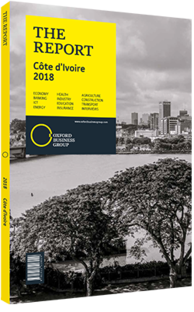Economic expansion driving insurance sector growth in Côte d'Ivoire
As the Ivorian economy has powered ahead in the past half-decade, insurance premiums have kept pace, regularly posting double-digit annual gains. According to the Association of Insurance Companies of Côte d’Ivoire (Association des Sociétés d’Assurances de Côte d’ Ivoire, ASA-CI), 2016 was no different with the total value of premiums growing by 9.1% to reach CFA304.4bn (€456.6m), equalling inflation-adjusted rises of 8.4% and 11.5% for the life and non-life segments, respectively. This growth was particularly impressive in the life sector, up 11.16% to hit CFA132.5bn (€198.8m), while the non-life sector posted gains of 7.64% to reach CFA171.9bn (€257.9m), according to ASA-CI data.
While a stable economy has been the main driver of rising premium figures, disposable income growth has been particularly important for the sector. As more families have money left over for discretionary goods, taking out property or life insurance products is becoming an increasingly feasible option.
Penetration
The recent increase in premiums bodes well for the sector; however, the insurance penetration rate still stood at 1.44% in 2016 – up from around 1% in 2013. Reflecting the relatively low level of per capita income, the sluggish development of its insurance sector and rapid population growth, insurance density in 2016 was also still relatively low at CFA12,800 (€19). This is compared with the advanced economy average of $350 (€286) and the emerging market average of $146 (€119), according to the Swiss Re “World Insurance in 2016” report.
One of the most profound changes in boosting penetration rates will need to address consumer spending habits. “With the exception of vehicles, insurance is mostly optional. Health insurance may be provided by an employer, but in general people have not developed a culture of taking out discretionary policies. This could change if insurance was made obligatory, or more awareness was raised about its benefits,” Patricia Gotta, former CFO at Allianz Côte D’Ivoire, told OBG.
Regional Comparison
However, despite what may be seen as a reluctance to take out coverage on the part of Ivorians, the sector has kept pace with some of the largest markets on the continent, where premiums have stagnated in recent years, with average inflation-adjusted growth of 0.8% posted in 2016 for the 10 African countries included on the Swiss Re report.
Slow growth has been largely driven by flat premiums in South Africa, the biggest insurance market by value on the continent at $42bn (€34.3bn) in 2016. Over 2015 and 2016 the South African market registered a respective 1.3% and 0.1% growth in inflation-adjusted terms. Morocco’s insurance market is the second-largest on the continent at $3.6bn (€2.9bn) in 2016, and represented the fasting growing African market that year, posting gains of 4.7% and 13.8% in 2015 and 2016, respectively. Nigeria, the only West African country covered in the report, is the continent’s largest economy, and its sixth-largest insurance market. Its economy was hit hard by the decline in global oil prices, and premiums slipped by 6.6% in 2015 and 11.4% the following year. Kenya, meanwhile, recorded premium growth of 3.9% in 2015 and 6% in 2016.
The average insurance penetration rate for African countries included in the Swiss Re report came in at 2.8%, although by country this number ranged from 14.3% in South Africa, the continent’s highest penetration rate, to less than 1% in Angola (0.81%), Algeria (0.8%), Egypt (0.64%) and Nigeria (0.27%). Insurance density, meanwhile, was $50 (€41), ranging from $6.20 (€5) in Nigeria to $763 (€624) in South Africa.
Looking Ahead
No doubt, economic expansion will be the principal driver of insurance premium growth. Meanwhile, as the country approaches emerging market status, premium rises should continue to comfortably outpace GDP, further boosting penetration levels. Furthermore, there is some evidence that Ivorians are starting to change the way they look at purchasing insurance products, which could impact the sector.
You have reached the limit of premium articles you can view for free.
Choose from the options below to purchase print or digital editions of our Reports. You can also purchase a website subscription giving you unlimited access to all of our Reports online for 12 months.
If you have already purchased this Report or have a website subscription, please login to continue.

